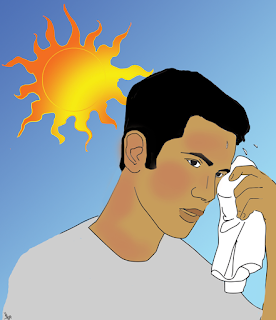 |
| Image Credit: Flickr |
Author: Kaitlin Fries, DO PGY-1
Doctors Hospital
Originally Published: Modern Resident June/July 2015
Heat-related illnesses are responsible for approximately 400 U.S. deaths each year.[4] Drastic spikes in mortality can be seen during severe droughts and heat waves, the latter of which is defined as temperatures greater than 90°F for three or more consecutive days.[3,4] Those at greatest risk for heat-related emergencies are children, the elderly, people with certain predisposing medical conditions and those taking medications that interfere with the body’s thermoregulatory center.[3,4] The spectrum of heat-related illnesses ranges from cramps, syncope and heat exhaustion to more serious conditions such as heat stroke. All of these conditions are easily preventable with public education and adequate access to hydration and cool shelters.
The main two cooling mechanisms used by the human body are radiation and evaporation.[2,3,4] Radiation can account for up to 65% of total heat loss.4 However, radiation can only occur in a cool environment. Patients who do not have access to air-conditioning must rely on evaporation to dissipate heat by producing sweat, which then evaporates from the skin’s surface due to body heat.[2] However, as atmospheric humidity increases, the effectiveness of evaporation decreases.[2] Below is a brief review of the minor presentations of heat-related complaints.
Heat Cramps
Heat cramps are painful, involuntary skeletal muscle spasms most commonly seen in the lower extremities.[2,3,4] Patients typically experience these muscle contractions during or several hours after vigorous physical activities.[3] This is thought to be secondary to dilutional hyponatremia and can be prevented by drinking electrolyte based sports drinks instead of water.[1,4] Treatment includes rest and salt replacement with an electrolyte-based solution.[1-4] In severe cases, IV rehydration with normal saline may be required.[3]
Heat Syncope
Heat syncope is another minor form of heat-related illness most commonly seen in non-acclimatized individuals, especially the elderly.[3] While standing in the heat, vasodilation causes blood to pool in peripheral vasculature, thus decreasing preload.[2] As the environmental temperature continues to increase, volume depletion is further worsened and eventually causes decreased vasomotor tone. Treatment consists of removing the patient from the warm environment, rest and oral/IV hydration.[1-4] If the patient fell, it is important to assess for any traumatic injuries.[4] It is also important to simultaneously rule out other serious causes of syncope in the elderly population.[3,4]
Heat Exhaustion
Heat exhaustion is the most commonly seen heat-related illness.[1] It is caused by a combination of volume and salt depletion.[1,2,3] Once again, it is most commonly seen in the elderly and individuals working in warm environments.3 These patients can present with any combination of the following complaints: headache, dizziness, weakness, nausea, vomiting, diaphoresis, myalgia, syncope, tachypnea, tachycardia and orthostatic hypotension.[1-4] It is important to note that in heat exhaustion core body temperature will not exceed 104°F.[1,2] Also, a key distinguishing factor between exhaustion and heat stroke is in heat exhaustion the patient will have a normal neurological exam.1,2 Laboratory values may show hemoconcentration and/or electrolyte abnormalities; however, liver function should be normal.[1,3] Treatment should consist of rest, oral/IV rehydration and electrolyte replacement as needed.[1-4] The majority of these patients can be discharged home. However, heat exhaustion can turn into heat stroke, so these patients should be observed until their symptoms have completely resolved.[3,4] Patients with a history of congestive heart failure or with serious electrolyte abnormalities may need admission for more aggressive rehydration.[3]
Stay tuned for the next issue to review heat stroke!
References:
- Ahmadi M. Environmental emergencies in: Blok BK, Cheung DS, Platts-Mills TF, eds. First aid for the emergency medicine boards. McGraw Hill; 2012. 13:723-725.
- Paquette R. Hippo Review: Heat cramps, heat exhaustion, heat syncope. 2015.
- Tintinalli JE. Tintinalli’s emergency medicine: A comprehensive study guide. McGraw Hill; 2011. 16:1339-1341.
- Tintinalli JE. Tintinalli’s emergency medicine: Just the facts. McGraw Hill; 2013. 13:424-425.
